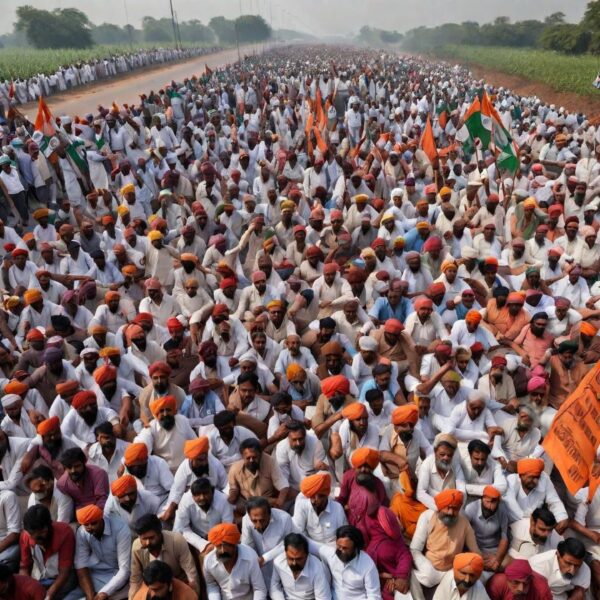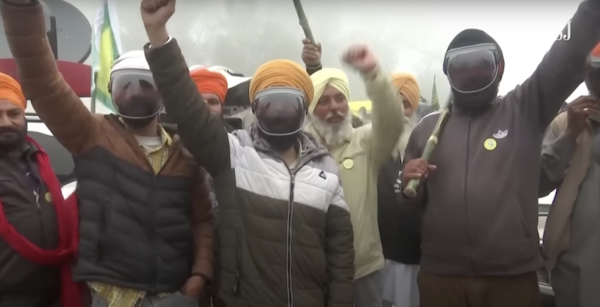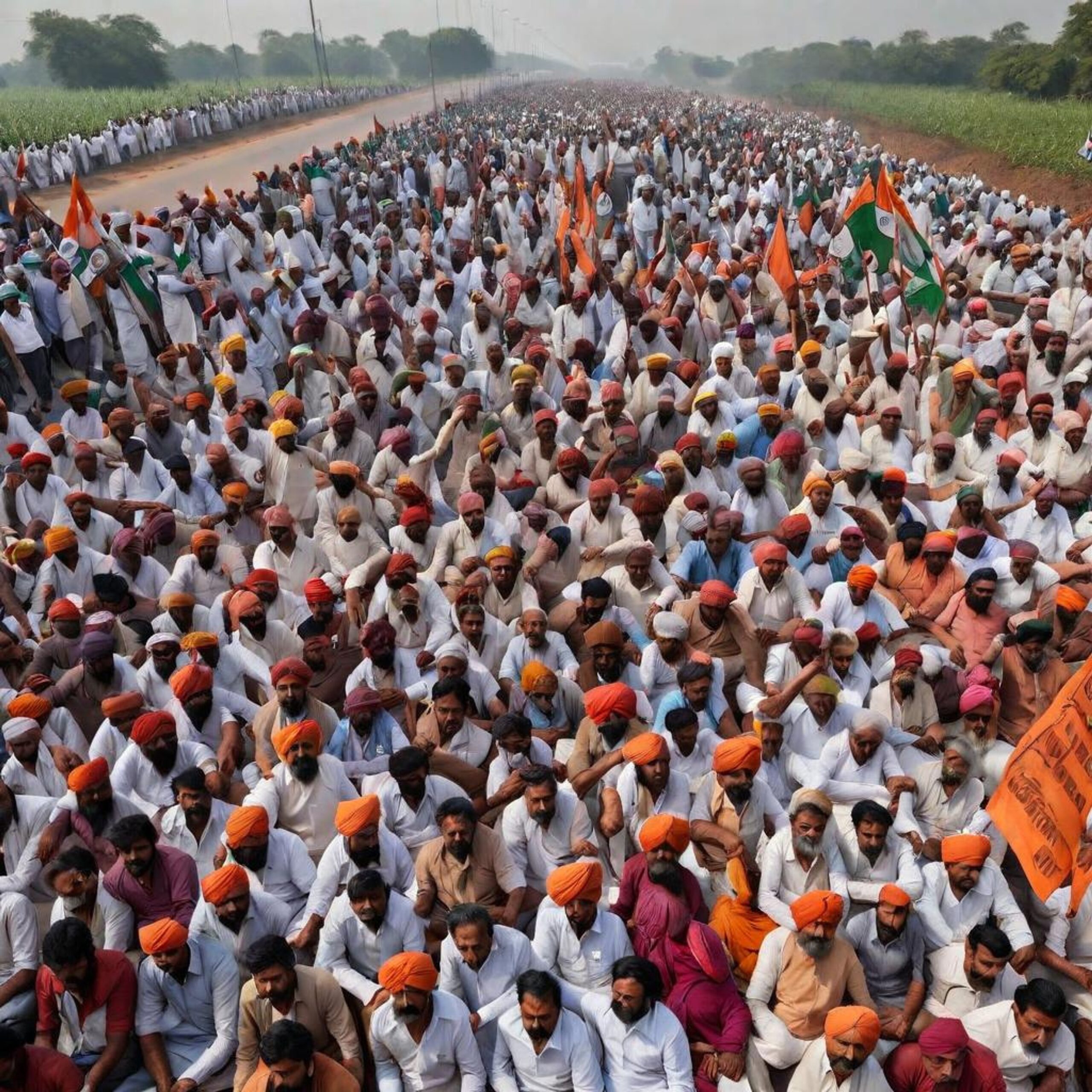On February 13, 2024, as reported by the Times of India, the Delhi police were on high alert. Without context, this sounds like a story reporting a country at war defending a mighty attack. However, this story reported the Delhi police’s defence against protests organised by Indian farmers, also considered to be the backbone of the country’s economy.
First Farmer Protest (2020-21)
The three controversial farm bills passed in September 2020 by the Indian parliament triggered mass protests and demonstrations by nearly three lakh farmers and their supporters. In essence, the laws aimed to privatise the agricultural sector by:
- Enabling private sectors to buy crops at market rates, sans taxes or tariffs, opposing government-determined prices.
- Permitting unlimited stockpiling of agricultural products by corporations.
- Empowering businesses to engage in contract farming without providing the farmers with appropriate legal remedies in case of disputes.
While the Agricultural Produce Marketing Committee Act passed in 1964 mandated farmers to sell their produce at mandis or markets regulated by the government, the new farm laws intended to bypass such systems. Consequently, this would grant increased control over the agricultural market to private corporations that could leverage their monopoly to manipulate the Minimum Support Price (MSP). However, the BJP administration justified the farm bills were beneficial to the farmers by affirming wider options in the market by allowing them to directly sell their produce to private players, dodging middlemen and the traditional mandi system.
The Indian agricultural sector has fundamental underlying problems including access to credit, lack of technology, high dependency on weather, and small land holdings. Although the high number of farmer suicides, acknowledged only for political leverage, demands policy reforms in the Indian agricultural sector, the three farm bills failed to mitigate or even address such structural issues. Facing severe backlash and protest for over a year, Prime Minister Modi repealed the farm bills in November 2021.

Dilli Chalo – Farmer Protest 2.0
On February 13, nearly 2 years after the first farmer protest, thousands of farmers started marching towards the national capital with multiple demands from the Central Government. Key demands from farmers include a legal guarantee of MSP for all crops, pensions for farmers, full debt waiver, implementation of the Swaminathan Commissions’ recommendations and ultimately the withdrawal of cases against farmers during the 2020 farmer protest. Although the protest started on the 13th, negotiations between the farmers and the Centre was underway with the first meeting between farmers and Union Ministers on February 8th followed by another meeting on the 12th of February.
However, to stop the farmers from marching into Delhi, the police erected barriers of barbed wires, spikes and cement blocks. Added to this, the BJP-led state government in Haryana suspended internet in seven districts, disrupting communications. The leader of Kisan Mazdoor Morcha (among the non-political forums leading the protest), Sarwan Singh appealed with the government to “either resolve issues or remove barricades and allow the protestors to proceed to Delhi to protest peacefully”. While scholars have argued that protests should be a fundamental democratic right for all citizens, the Central government in tandem with relevant State governments attempted to suppress the farmers’ movements. As mentioned above, with multiple entry points being blocked and the internet shut down in several districts, the Delhi police also imposed Section 144 which restricted large gatherings. In an attempt to stop the protesting farmers from marching towards Delhi despite the restrictions, the Delhi police fired tear gas with drones flying over the crowds deploying tear gas continuously, bringing back devastating memories of the previous farmer protest where a significant number of lives were lost.
Although there were differences including primarily the protest demands and the leadership between the farmers’ protest of 2020-21 and farmers’ protest in 2024, patterns of government restrictions, brutal police force and violence have prevailed in both the protests. While this reveals the current administration’s attempts to undermine democracy, examining media’s representation of the Dilli Chalo movement will help understand their fourth pillar responsibilities.
Habermas’s Public Sphere and the Indian Media
Jürgen Habermas, a German philosopher, outlined the transformation from the 18th century coffee-shops to an advanced, media-first public sphere of the 20th century. With increased commercialisation and capital interests in media audiences are regarded as customers, promoting business-like relation. Political elites including journalists, spin-doctors and actors are actively involved in setting media agenda and curating the information available to the public. Therefore, the current media landscape has warranted a one-way style communication where the public plays a passive role. Although Indians rely on alternative platforms for news, broadcast and print media play a crucial role with scores of citizens still dependent of them.
The diverse population of 1.4 billion diverse people in India has consequently impacted the media landscape which is extensive and intrinsic. Through the advent and innovation of several print, electronic and broadcast media including 24-hour news channels, the Indian media landscape has evolved rapidly and significantly. However, trends of concentration of ownership and biased reporting is common owing to direct ownership and government advertisements and contracts that form a key source of income. An elected BJP MP starting the Republic TV, NDTV takeover by Adani, Modi administration suspending advertisements in popular publications for being critical align with Habermas’s “mediated political communication carried by politics elites”. Therefore, with increased control over the media, the possibilities of excluding groups by directly controlling the narrative and influencing the public opinion is heightened.

The Mainstream Media and Farmer Protest 2.0
The majority of national media outlets are owned by businesses that either control a significant share of the economy or those that have strong ties with the government. Moreover, journalists and activists are detained by authorities under fabricated terrorism or sedition charges, including during the first farmer’s protest, critics are classified as anti-national and media organisations face politically motivated raids under accusations of tax evasions or fraudulent practices. While this is testimonial to the Modi administration’s use of political influence to silence critiques, the Indian press is consequently heavily restricted. Both the farmer’s protests have been crucial in exposing the Godi media (media operating under the government’s lap) and its failure in challenging the government, which has led to a decline in a free and independent media.
A story published by The Jaipur Dialogues, claimed that the protesting farmers are “mocking Bharat and Punjab by asking for ‘Pakistan Bano!’”. Further, calling them ‘alcohol-drinking part-time protestors’, and ‘Khalistani terrorists’, the article maintained the farmers are undermining democracy through these protests. Another article published by OpIndia alleged that all the protesting Sikhs intended to join Pakistan and attack Hindu temples. Organiser Weekly further proposed an “interesting angle” stating that the left-wing media is unaware of the farmer’s detailed list of demands and is only influencing public opinion by “creating a buzz through SEO”.
While these platforms are known to have a clear bias and hence is not always a reliable source of public information, they have a significant number of subscribers and followers. The Jaipur Dialogue, for example, has a YouTube following of nearly 1.42 million subscribers. Moreover, OpIndia had nearly 4.9 million visits in the month of February, when the article was published. Therefore, these platforms play a key role in shaping public opinion and influencing discourse. Bulk of such claims, coupled with other stories posted on social media have been classified as false or fake by fact-checkers. Moreover, such highly biased stories are still hosted on these platforms, without clarifications or corrections, revealing a significant degradation of journalistic standards and the information environment in general. However, arguing that the intrinsic media landscape in its totality has failed to report accurately on the farmer protest through stories published by organisations with clear affiliations or leanings is not sufficient. Here, scrutinising the reporting of popular media organisations with a considerable following becomes critical.
Majority of visuals on mainstream media was devoted to farmers in tractors and bulldozers advancing towards the national capital, coupled with scenes of traffic jams and reporters announcing the disruptions caused to daily commuters. An article detailing visuals on broadcast channels and the subsequent headlines on newspapers on the day of and after the protest illustrates how such stories impacting personal lives results in an obvious decline of public sympathy. Added to this, Arnab Goswami’s primetime debate titled “Farmers’ ‘protest’ – A larger plot?” went on to “expose luxury protest” claiming “Congress ready to play junior partner”. Republic TV, with a market share of 47.1%, dominates viewership among other English language news broadcasters. The channel often sensationalises news, use provocative hashtags and negative words that instil a feeling of fear or helplessness among their audience. “Potentially being funded by Cannada”, the channel also claimed the farmers were holding the national capital to ransom. Furthermore, with an objective to illegitimise the protesting farmers by exposing “fake protestors from strong financial backgrounds”, a debate on another channel, News18 India, revealed a Sikh man on a Mercedes-Benz SUV. However, Alt News verified the image was not from the farmers’ protest and further tracked the owner, who said he was disheartened by how his car was used to discredit the farmers’ protest. While it is the journalist’s responsibility to publish verified information and fact-check their content, News18 India’s fact-checking record is questionable filled with false claims even outside of the protests. While Republic TV and News18 are some prominent examples of media organisations resorting to sensationalising news, aggressive debates, and amplifying misinformation, scores of other Indian organisations are criticised for their style of reporting. This has greatly contributed to a decline in journalistic standards and the fourth pillar’s ability to hold governments accountable.
With a void created by the Indian media, new media’s potential for an alternative sphere to accurately represent the farmer protest was heightened. In contrast to the mediatised public sphere mandating a one-way type of communication, social media platforms like Twitter and Facebook enabled users to engage with political institutions while producing content. American musician, Rihana’s tweet “why aren’t we talking about this?!” in 2021 during the first farmer’s triggered a global dialogue about the protest. Soon after, prominent leaders including climate activist Greta Thunberg voiced their support for the protesting Indian farmers. However, the Indian government issued a statement criticising foreign individuals of sensationalising news on social media. Added to this, counter-protestors, burning photos of Rihanna and Greta Thunberg (at the time still a teenager), declared international interference would not be tolerated. Twitter was also instructed by the government to block numerous accounts and posts supporting the protest. Farmer protest 2.0 witnessed similar internet shutdowns with numerous users also complaining their accounts were blocked or restricted. X (formerly Twitter) posted a tweet stating that the Indian government issued an executive order to withhold certain accounts subject to penalties including imprisonment. Accounts of several activists, journalists, and farm unionists covering the farmers’ protest were hence suspended. While these platforms warranted an egalitarian information and communication system, government restrictions and corporate interests impeded such potential.
Conclusion
V-Dem, a Swedish institute that tracks democratic freedom worldwide, categorised the India an electoral autocracy in 2018. In 2024, a further decline in metrices resulted in the country being categorised as “one of the worst autocracies”. While the fourth pillar is responsible to hold governments accountable, India’s press freedom index is ranked 161 out of 180 countries across the world. Therefore, a complete breakdown of a democratic government and responsible media is prevalent. With a highly partisan media and increased government control, expecting dissent to be accurately represented in the public sphere is almost utopian. Similar issues were found with the mainstream media’s representation of the Dilli Chalo movement. Although the Indian Twittersphere provided an alternative, corporate interests along with the BJP administrations attempts to control the narrative blocked such potential. While both the farmer protests have thrived to challenge the Godi media, all else point to the steep decline in the democratic standards of the world’s largest democracy.
About The Author

I’m Pranav Rao, a graduate of MA in Political Communication from the School of Journalism, Media and Culture, Cardiff University. My research interest includes the rise in right-wing populist governments, public opinion and the media’s representation of democracies. Through my research and work, I aim to inspire positive political decisions.










